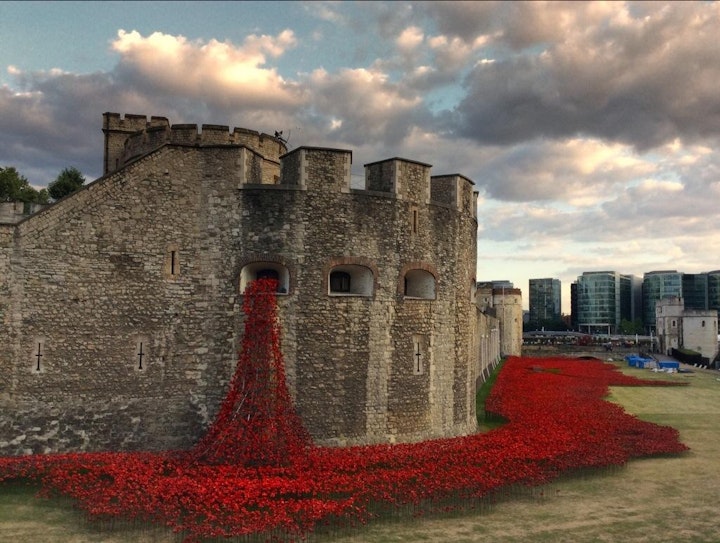'Blood Swept Lands and Seas of Red' is a major art installation at the Tower of London, marking one hundred years since the first day of the First World War. It has been created by ceramic artist Paul Cummins and stage designer Tom Piper. The installation includes 888,246 ceramic poppies each representing a British military fatality during the war. The installation evolved over the course of the summer as more poppies were installed around the moat of the tower with the main feature being a cascade of flowers showering down the wall from a window on the north wall.
The scale of this piece is huge and successfully captures the enormity of loss experienced during the war. I visited on an early morning before the crowds were too busy, it was a crisp and very bright autumn day, adding to the picturesque setting and thought provoking experience.
It is a thing of real beauty which adds colour and interest to the already powerful presence of this ancient landmark. The crowds which flood to the installation every day have grown as the piece has evolved and it has become a key talking point over the last few months, on the news and among friends. The way this installation was created and gradually installed seems to have really captured the heart of the public who are keen to not only see this impressive work of art but also get actively involved by constructing a flower, installing one and even buying one.
It was not surprising that this piece was created by a theatre designer, the dramatic impact, the thought around the audience experience and the unity with the building are all skills of the theatre practitioner. The collaboration with a ceramic artist has combined this experiential work with that of a beautiful object. Each flower is unique, handmade and pretty to behold. The impact of these flowers on mass produces this landscape of red and the process of mounting them on stalks gives this sense of movement and flow.
The history, heritage and remembrance links are very apparent and of course vivid in ones mind when viewing the work. The image from the time which particularly sticks in my mind is a photograph of troops gathered round the moat, where the poppies now lie. The mass of men, all city workers, lined up and ready to leave for the front is in itself heart trenching but now seen in relation to the poppies and the image of a sea of blood and the understanding of facts on how many men died is exceptionally moving.
The real success of this work is the simplicity of the idea yet the very clever creation of a public event which generates interest, awareness and public good. The work ticks so many boxes of what makes a good pice of public art and does this in a successful and genuine way. It looks impressive as a visual piece, it works in harmony to transform an iconic landmark and already major tourist attraction, it has meaning, it has history, it raises awareness, it gets people involved, and has sparked national and international discussion. Above all and maybe it's lasting legacy is that it is also raising money for charity through the selling of the ceramic flowers. This is a public piece commissioned using public money that gives back both in experience and financially.
I left the tower and headed to monument station where I saw a small old man selling a range of poppy pins. I donated £2 for a lasting metal broach and pinned it proudly on my bag.

